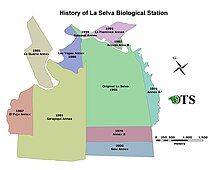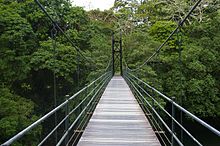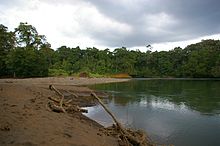La Selva Biological Station
Coordinates: 10 ° 25 ′ 19 ″ N , 84 ° 0 ′ 54 ″ W.
La Selva Biological Station is a research station in Costa Rica with a protected area of 1,600 hectares of tropical rainforest . It is owned by the Organization for Tropical Studies (OTS), a non-profit consortium consisting of 63 universities and research institutions from the USA, Latin America and Australia. La Selva is one of the most productive field research stations for tropical ecology in the world, hosts around 300 scientists annually and is the venue for over 100 courses per year. The aim of the research station is to maintain an intact tropical rainforest, to offer the possibility of sustainable research and training by providing laboratory space and accommodation for researchers and students, and to teach the local population about sustainability and nature conservation. Additionally, La Selva Biological Station is an important destination for ecotourism in Costa Rica.
history
La Selva Biological Station was founded in 1953 by the botanist Leslie Holdridge . He originally bought the land for his own research purposes to use various tree crops, in which the natural forest does not have to be completely cleared. When it was founded, La Selva was relatively difficult to reach. Long washed-out dirt roads were followed by a 4 km canoe trip on the Rio Puerto Viejo . In 1968 the Organization for Tropical Studies (OTS) bought the area for US $ 50,000 to make it a private reserve and biological station. At the time, the OTS was a small, only five-year-old organization with the aim of enabling research and scientific training in the tropics. Holdridge approached OTS and offered the organization his land as a research station before OTS bought the area from him. Holdrige supported the research at La Selva until his death in 1999. There have been some drastic changes since the station was founded in 1953. The station has become easier to get to, laboratory buildings and accommodation have been built, and the reserve has grown three times as much. At the same time, the agricultural use of the surrounding area, in particular the size of the banana plantations , as well as the population density in the settlements around the station has increased, which is why La Selva has become even more important as a protected area for primary rainforest .
Geography and geology
La Selva Biological Station is located within the Cordillera Volcánica Central Biosphere Reserve (91,000 ha) in the north-eastern lowlands of Costa Rica. In the north the station borders on the Rio Puerto Viejo , in the west on the Rio Sarapiquí and the Rio Peje . Along the rivers you can find deposits from the Holocene and Pleistocene , which primarily consist of inceptisols and entisols . The interior of the reserve consists mostly of ultisoles .
In the south, La Selva crosses a 4-6 km wide connecting corridor into the Braulio Carillo National Park (47,000 ha). La Selva is located in the physiogeographical transition between the foot of the Barva volcano and the alluvial plains of the Caribbean coast. The northern end of the park is around 35 m above sea level, while the highest altitude is around 137 m above sea level in the southwest corner. The transect from La Selva through the Braulio Carillo National Park to the Barva volcano (approx. 55 km) contains ecosystems of the tropical rainforest . With about 1,200 inhabitants, Puerto Viejo de Sarapiquí is the largest village in the area and is located about 7 km north-east of La Selva. The station can be reached from the capital San José by public bus or car in less than 2 hours.
Temperatures average 25 ° C and vary between 16 ° C and 37 ° C. Every year around 400 mm of rain falls. The rainiest months are November and December, the least rain falls in February, March and April, although there is no really pronounced dry season.
Flora and fauna
flora
55% of the area of La Selva is characterized by the species-rich, multi-layered primary rainforest . The rest of the forest consists of secondary forest , abandoned plantations in different phases of succession , forest sections with selective logging and forest areas modified for scientific purposes. There are over 5,000 vascular plants within La Selva , including over 700 species of trees such as Welfia regia , the stilt palm Socratea exorrhiza and the Pentaclethra macroloba, which occurs in unusual densities in La Selva . In addition, there is a large variety of epiphytes and epiphylls . La Selva has a 3.5 hectare arboretum , which was founded in 1968 and consists of over 240 tree species from 60 families and 171 genera.
Mammals
La Selva is home to 65 species of bats , 16 species of rodents , 5 species of opossums and howler monkeys , spider monkeys , white-headed Capuchin , three- and two-toed sloth , nine-banded armadillos , great anteaters , dwarf anteater and Northern Tamandua , Großmazamas , white-tailed deer , Weißbart- and Halsbandpekari , tapir , Tayras , Amazon skunks , Großgrisons , South American otter , Olingos , winding bears , raccoons , coati , pumas , jaguars , ocelots , margays and jaguarundis .
Birds
Every year in December the “Christmas Bird Count” takes place, during which local and foreign ornithologists systematically record all birds for a day. In 2012, 348 bird species were registered (2011: 338; 2010: 368). A total of 517 bird species have been sighted in La Selva since the official record began.
Reptiles and amphibians
Thanks to the well-developed walkways in the Canterana Swamp, amphibians such as the red -eyed tree frog , the "blue jeans" color variant of the strawberry frog and occasionally the golden tree climber can be observed. The Terciopelo lance viper and the hook-nosed lance viper are the most common venomous snakes in La Selva. Other well-known reptiles are the prehensile tailed lance viper , the idol snake , green iguanas and basilisk .
Arthropods
In La Selva you can find over 450 ants and 5,000 species of butterflies, many of which are still unknown. The most famous arthropod species include the golden silk spider , the blue morpho butterfly and the dreaded 24-hour ant , whose sting is known as the most painful insect sting ever.
Research and tourism
According to its own information, over 240 scientific publications on research in La Selva are brought out every year. Current long-term projects are researching the biodiversity of ants , bats , birds , cichlids and various plant groups, as well as water ecology , the interaction of trophic levels and the effects of climate change on the ecology of the tropical rainforest. The research station consists of two laboratories with microscopes, refrigerators and freezers, sterile workbenches and other material for laboratory work. There are also five houses as accommodation for scientists, three group accommodations for students, a canteen, a reception with a kiosk, three seminar rooms, a herbarium, a library and office space. There are three separate family houses available for scientists with families. An extensive path system with over 50 km of partly paved paths simplifies access to the forest. The entire area is divided into an area network of 50 × 100 m and provided with marker posts, which are recorded and mapped by the geographic information system. For tourists there are two comfortable houses with four rooms each. In consultation with the scientists, interested parties can get an insight into research in La Selva. In addition, local English-speaking guides offer tours on various topics, such as bird watching, night walks and introductions to the ecology of the tropical rainforest.
Threat and Safeguards
La Selva Biological Station is located in an extensively farmed and populated area. The biggest problem is the loss of ecological compensation areas in the vicinity of the station and the general habitat fragmentation in poaching . Illegally hunted animals include the iguana , the white-tailed deer , the great mazama , the paka , and birds from the cocoon family . In a study in the area in and around La Selva, 4% of those questioned admitted to having shot at least one of these animals in the year before the survey. La Selva therefore has a team of game rangers who regularly patrol the area to prevent poaching.
Web links
- Tree species of the arboretum (PDF; English)
- Official Website of La Selva Biological Station (English)
Individual evidence
- ↑ Michener, W., Bildstein, K., McKee, A., Parmenter, R., Hargrove, W., McClearn, D., & Stromberg, M. (2009) Biological field stations: research legacies and sites for serendipity. BioScience 59, pp. 300-310.
- ^ A b c d Moorman, R. (2006) Benefits of local residents visiting La Selva Biological Station, Costa Rica. Environmental Conservation, pp. 88-99
- ↑ a b c d McDade, L., Bawa, K., Hespenheide, H., & Hartshorn, G. (1994) La Selva: Ecology and natural history of a Neotropical rain forest. Chicago: The University of Chicago Press
- ↑ a b c d e Matlock, R., & Hartshorn, G. (1999) La selva biological station (OTS). Bulletin of the Ecological Society of America, pp. 188-193.
- ↑ Database with meteorological data from La Selva Biological Station (English)
- ↑ a b Official website of La Selva (English)
- ↑ List of mammal species in La Selva
- ↑ Christmas Bird Count in La Selva ( Memento of the original from January 16, 2014 in the Internet Archive ) Info: The archive link was inserted automatically and has not yet been checked. Please check the original and archive link according to the instructions and then remove this notice. (Spanish)
- ↑ Mahmood, SA; Wasko, DK; Lamar, WW (2009) Natural history of the terciopelo Bothrops asper (Serpentes: Viperidae) in Costa Rica. Toxicon 54, pp. 904-922









